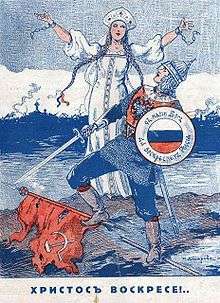Personifications of Russia
Since medieval times personifications of Russia are traditionally feminine, and most commonly are maternal.[1]

Most common terms for national personification of Russia are:
- Mother Russia (Russian: Матушка Россия, tr. Matushka Rossiya, "Mother Russia"; also, Россия-матушка, tr. Rossiya-matushka, "Russian Mother", Мать-Россия, tr. Mat'-Rossiya, Матушка Русь, tr. Matushka Rus' , "Mother Rus' "),
- Mother Motherland (Russian: Родина-мать, tr. Rodina-mat' ).
Notice that in Russian language, the concept of motherland is rendered by two terms: "родина" (tr. rodina), literally, "place of birth" and "отчизна" (tr. otchizna), literally "fatherland".
Harald Haarmann and Orlando Figes see the goddess Mokosh a source of the "Mother Russia" concept.[2][3]
Usage
During The October Revolution and The Civil War, the image was in the propaganda of the supporters of the White movement, interpreting the struggle against the Bolsheviks as a battle with "aliens" as "oppressors of Mother Russia".
Statues
During the Soviet era, many statues of Mother Motherland were built, most to commemorate the Great Patriotic War. These include: Rodina-mat' zovot
- The Motherland Calls (Russian: Родина-мать зовёт, tr. Rodina-mat' zovot) a colossal statue in Volgograd, Russia, commemorating the Battle of Stalingrad
- Mother Motherland, Kiev (Ukrainian: Батьківщина-Мати, tr. Batʹkivshchyna-Maty, "Motherland Mother") or, and more commonly referred to as, Rodina-Mat (Russian: Родина-мать, tr. Rodina-mat' ) is a monumental statue that is a part of the Museum of The History of Ukraine in World War II.
- Mother Motherland (Saint Petersburg), a statue at the Piskarevskoye Memorial Cemetery, St. Petersburg, Russia
- Mother Russia (Kaliningrad), a monument in Kaliningrad, Russia.
- Mother Motherland Mourning over Her Perished Sons (Russian: Родина-мать, скорбящая о погибших сыновьях, tr. Rodina-mat', skorbyashchaya o pogibshikh synov'yakh), Minsk, Belarus commemorating the dead in Afghanistan.
- Mother Motherland (Naberezhnye Chelny), a monument in Naberezhnye Chelny, Russia[4].
- Mother Motherland (Pavlovsk), a memorial complex, Pavlovsk, Russia[5].
See also
References
- ↑ Рябов О. В. (1999). Русская философия женственности (XI—XX века). Иваново. pp. 35–46.
- ↑ Harald Haarmann, The soul of Mother Russia: Russian Symbols and Pre-Russian Cultural Identity, ReVision, June 22, 2000 (retrieved May 2, 2016)
- ↑ Figes, Orlando (2002). Natasha's Dance: a cultural history of Russia. New York: Metropolitan Books. p. 321. ISBN 9780805057836.
[...] the goddess known as Mokosh, from whom the myth of 'Mother Russia' was conceived.
- ↑ Казань. Храм на шести сотках — Ольга Юхновская."Не йог, не маг и не святой" — Российская Газета — Этот объект не включен в программу подготовки к казанскому миллениуму. Но его, без сомнений, будут показывать гостям города как редкую достопримечательность. Создатель множества памятников, художник из пригорода Казани Ильдар Ханов к тысячелетию столицы Татарстана строит на своем участке храм всех религий. В свое время творчество Ханова высоко оценил Святослав Рерих
- ↑ "Archived copy". Archived from the original on 2011-01-24. Retrieved 2012-11-02.
Further reading
- Ellen Rutten, Unattainable Bride Russia: Gendering Nation, State, and Intelligentsia in Russian Intellectual Culture, 2010, ISBN 0810126567. The book discusses personifications of Russia as a bride in 20th century Russian literature and art.
External links
